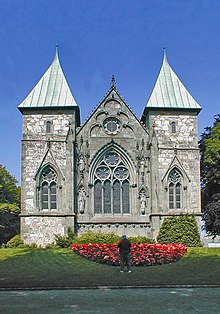Stavanger Cathedral
| Stavanger Cathedral | |
|---|---|
| The Cathedral of Saint Swithun | |
Stavanger domkirke | |
 View of the Cathedral | |
| 58°58′11″N 5°43′59″E / 58.969787°N 5.733162°E | |
| Location | Stavanger, Rogaland |
| Country | Norway |
| Denomination | Church of Norway |
| Previous denomination | Catholic Church |
| Churchmanship | Evangelical Lutheran |
| Website | stavangerdomkirke.no |
| History | |
| Status | Cathedral |
| Founded | c. 1125 |
| Founder(s) | Bishop Reinald |
| Dedication | Saint Swithun |
| Architecture | |
| Functional status | Active |
| Style | Romanesque/Gothic |
| Completed | c. 1150 |
| Specifications | |
| Capacity | 800 |
| Materials | Stone |
| Administration | |
| Diocese | Diocese of Stavanger |
| Deanery | Stavanger domprosti |
| Parish | Stavanger |
| Clergy | |
| Bishop(s) | Erling Johan Pettersen |
Stavanger Cathedral (Norwegian: Stavanger domkirke) is Norway's oldest cathedral and the seat of the Bishop of Stavanger who leads the Diocese of Stavanger. It is located in the city of Stavanger in Rogaland county, Norway. The church is situated in the centre of the city, in the borough of Storhaug between Breiavatnet in the south, the square with Vågen in the north west, the cathedral square in the north, and Kongsgård in the southwest.
The church is part of the "Stavanger domkirke" parish in the Stavanger arch-deanery in the Diocese of Stavanger.[1][2]
History
Bishop Reinald, who may have come from Winchester, is said to have started construction of the cathedral around 1100. It was finished around 1150: the city of Stavanger counts 1125 as its year of foundation. The cathedral was dedicated to Saint Swithun, an early Bishop of Winchester and subsequently patron saint of Winchester Cathedral.[3] The church was initially the seat of the Diocese of Stavanger within the Roman Catholic Church until the Protestant Reformation. [4] [5]
Stavanger was ravaged by fire in 1272, and the cathedral suffered heavy damage. It was rebuilt under Bishop Arne (1276–1303) at which time the Romanesque cathedral was enlarged in the Gothic style. [6]
In 1682, King Christian V decided to move Stavanger's episcopal seat to Kristiansand, in Kristiansand Cathedral. However, on Stavanger's 800th anniversary in 1925, King Haakon VII appointed Jacob Christian Petersen (1870-1964) to serve as Stavanger's first bishop in nearly 250 years.
During a renovation in the 1860s, the cathedral's exterior and interior were considerably altered. The stone walls were plastered, and the building lost much of its medieval appearance. A major restoration led by architect Gerhard Fischer in 1939–1964 partly reversed those changes. The latest major restoration of the cathedral was conducted in 1999. Scottish craftsman Andrew Lawrenceson Smith (ca. 1620-1694) is well-known for his works in Stavanger Cathedral. [7]
At the entrance to the sacristy there are sculptures of King Magnus VI, King Eric II and King Haakon V. The baptismal font is estimated to be from around 1300. The Bishop's chair is from 1925. [8]
Media gallery
-
Exterior view
-
Front view
-
Rear view (east end)
-
Nave
-
Baptismal font
-
Doorway on the south side
-
Bishop’s Chair
-
Choir window
-
Pulpit
-
Bust of King Eric II
See also
References
- ^ "Stavanger domkirke". Kirkesøk: Kirkebyggdatabasen. Retrieved 2016-05-01.
- ^ "Oversikt over Nåværende Kirker" (in Norwegian). KirkeKonsulenten.no. Retrieved 2016-05-01.
- ^ "Ancient See of Stavanger". Catholic Encyclopedia.
- ^ Jan Henrik Schumacher. "Reinald". Norsk biografisk leksikon. Retrieved September 1, 2018.
- ^ "St Swithun: The Cathedral's Patron Saint". Winchester Cathedral. Retrieved September 1, 2018.
- ^ "Stavanger Domkirke". Stavangers murarkitektur. Retrieved September 1, 2018.
- ^ Kjartan Fløgstad. "Anders Smith, Billedskjærer & Maler". Norsk biografisk leksikon. Retrieved September 1, 2018.
- ^ "Stavanger Cathedral Church". Kulturminnesok. Retrieved September 1, 2018.
Related reading
- Hoftun, Oddgeir (2008) Kristningsprosessens og herskermaktens ikonografi i nordisk middelalder (Oslo: Solum forlag) ISBN 978-82-560-1619-8
- Ekroll, Øystein; Stige, Morten (2000) Middelalder i Stein (Oslo : ARFO) ISBN 82-91399-09-3












